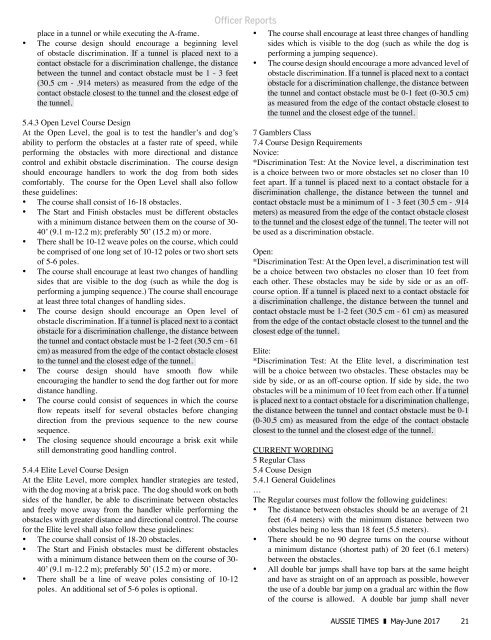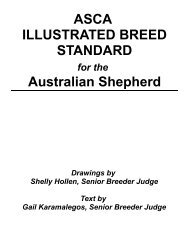Create successful ePaper yourself
Turn your PDF publications into a flip-book with our unique Google optimized e-Paper software.
place in a tunnel or while executing the A-frame.<br />
• The course design should encourage a beginning level<br />
of obstacle discrimination. If a tunnel is placed next to a<br />
contact obstacle for a discrimination challenge, the distance<br />
between the tunnel and contact obstacle must be 1 - 3 feet<br />
(30.5 cm - .914 meters) as measured from the edge of the<br />
contact obstacle closest to the tunnel and the closest edge of<br />
the tunnel.<br />
5.4.3 Open Level Course Design<br />
At the Open Level, the goal is to test the handler’s and dog’s<br />
ability to perform the obstacles at a faster rate of speed, while<br />
performing the obstacles with more directional and distance<br />
control and exhibit obstacle discrimination. The course design<br />
should encourage handlers to work the dog from both sides<br />
comfortably. The course for the Open Level shall also follow<br />
these guidelines:<br />
• The course shall consist of 16-18 obstacles.<br />
• The Start and Finish obstacles must be different obstacles<br />
with a minimum distance between them on the course of 30-<br />
40’ (9.1 m-12.2 m); preferably 50’ (15.2 m) or more.<br />
• There shall be 10-12 weave poles on the course, which could<br />
be comprised of one long set of 10-12 poles or two short sets<br />
of 5-6 poles.<br />
• The course shall encourage at least two changes of handling<br />
sides that are visible to the dog (such as while the dog is<br />
performing a jumping sequence.) The course shall encourage<br />
at least three total changes of handling sides.<br />
• The course design should encourage an Open level of<br />
obstacle discrimination. If a tunnel is placed next to a contact<br />
obstacle for a discrimination challenge, the distance between<br />
the tunnel and contact obstacle must be 1-2 feet (30.5 cm - 61<br />
cm) as measured from the edge of the contact obstacle closest<br />
to the tunnel and the closest edge of the tunnel.<br />
• The course design should have smooth flow while<br />
encouraging the handler to send the dog farther out for more<br />
distance handling.<br />
• The course could consist of sequences in which the course<br />
flow repeats itself for several obstacles before changing<br />
direction from the previous sequence to the new course<br />
sequence.<br />
• The closing sequence should encourage a brisk exit while<br />
still demonstrating good handling control.<br />
5.4.4 Elite Level Course Design<br />
At the Elite Level, more complex handler strategies are tested,<br />
with the dog moving at a brisk pace. The dog should work on both<br />
sides of the handler, be able to discriminate between obstacles<br />
and freely move away from the handler while performing the<br />
obstacles with greater distance and directional control. The course<br />
for the Elite level shall also follow these guidelines:<br />
• The course shall consist of 18-20 obstacles.<br />
• The Start and Finish obstacles must be different obstacles<br />
with a minimum distance between them on the course of 30-<br />
40’ (9.1 m-12.2 m); preferably 50’ (15.2 m) or more.<br />
• There shall be a line of weave poles consisting of 10-12<br />
poles. An additional set of 5-6 poles is optional.<br />
Officer Reports<br />
• The course shall encourage at least three changes of handling<br />
sides which is visible to the dog (such as while the dog is<br />
performing a jumping sequence).<br />
• The course design should encourage a more advanced level of<br />
obstacle discrimination. If a tunnel is placed next to a contact<br />
obstacle for a discrimination challenge, the distance between<br />
the tunnel and contact obstacle must be 0-1 feet (0-30.5 cm)<br />
as measured from the edge of the contact obstacle closest to<br />
the tunnel and the closest edge of the tunnel.<br />
7 Gamblers Class<br />
7.4 Course Design Requirements<br />
Novice:<br />
*Discrimination Test: At the Novice level, a discrimination test<br />
is a choice between two or more obstacles set no closer than 10<br />
feet apart. If a tunnel is placed next to a contact obstacle for a<br />
discrimination challenge, the distance between the tunnel and<br />
contact obstacle must be a minimum of 1 - 3 feet (30.5 cm - .914<br />
meters) as measured from the edge of the contact obstacle closest<br />
to the tunnel and the closest edge of the tunnel. The teeter will not<br />
be used as a discrimination obstacle.<br />
Open:<br />
*Discrimination Test: At the Open level, a discrimination test will<br />
be a choice between two obstacles no closer than 10 feet from<br />
each other. These obstacles may be side by side or as an offcourse<br />
option. If a tunnel is placed next to a contact obstacle for<br />
a discrimination challenge, the distance between the tunnel and<br />
contact obstacle must be 1-2 feet (30.5 cm - 61 cm) as measured<br />
from the edge of the contact obstacle closest to the tunnel and the<br />
closest edge of the tunnel.<br />
Elite:<br />
*Discrimination Test: At the Elite level, a discrimination test<br />
will be a choice between two obstacles. These obstacles may be<br />
side by side, or as an off-course option. If side by side, the two<br />
obstacles will be a minimum of 10 feet from each other. If a tunnel<br />
is placed next to a contact obstacle for a discrimination challenge,<br />
the distance between the tunnel and contact obstacle must be 0-1<br />
(0-30.5 cm) as measured from the edge of the contact obstacle<br />
closest to the tunnel and the closest edge of the tunnel.<br />
CURRENT WORDING<br />
5 Regular Class<br />
5.4 Couse Design<br />
5.4.1 General Guidelines<br />
…<br />
The Regular courses must follow the following guidelines:<br />
• The distance between obstacles should be an average of 21<br />
feet (6.4 meters) with the minimum distance between two<br />
obstacles being no less than 18 feet (5.5 meters).<br />
• There should be no 90 degree turns on the course without<br />
a minimum distance (shortest path) of 20 feet (6.1 meters)<br />
between the obstacles.<br />
• All double bar jumps shall have top bars at the same height<br />
and have as straight on of an approach as possible, however<br />
the use of a double bar jump on a gradual arc within the flow<br />
of the course is allowed. A double bar jump shall never<br />
AUSSIE TIMES May-<strong>June</strong> <strong>2017</strong> 21



